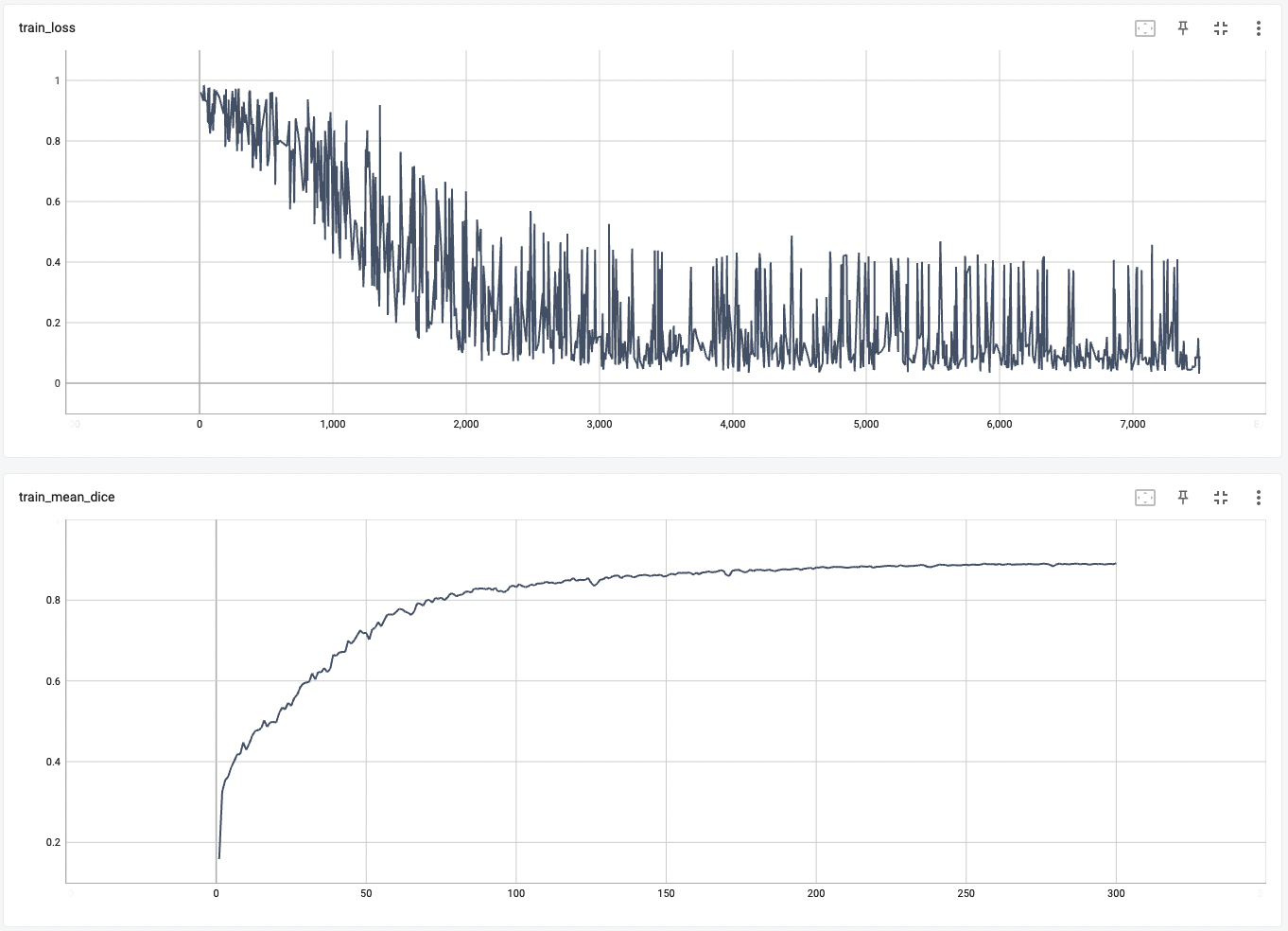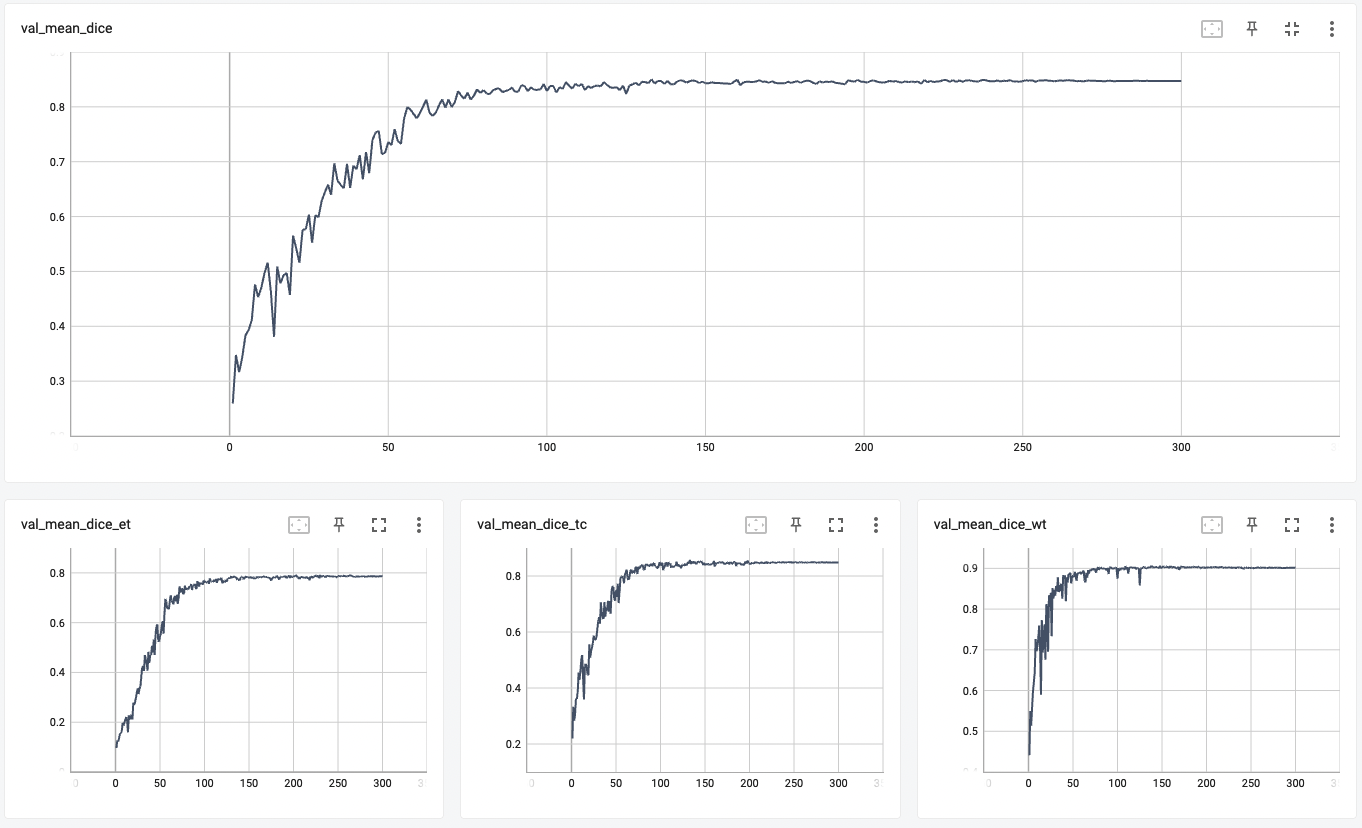|
--- |
|
tags: |
|
- monai |
|
- medical |
|
library_name: monai |
|
license: apache-2.0 |
|
--- |
|
# Model Overview |
|
A pre-trained model for volumetric (3D) segmentation of brain tumor subregions from multimodal MRIs based on BraTS 2018 data. |
|
|
|
The model is trained to segment 3 nested subregions of primary brain tumors (gliomas): the "enhancing tumor" (ET), the "tumor core" (TC), the "whole tumor" (WT) based on 4 aligned input MRI scans (T1c, T1, T2, FLAIR). |
|
- The ET is described by areas that show hyper intensity in T1c when compared to T1, but also when compared to "healthy" white matter in T1c. |
|
- The TC describes the bulk of the tumor, which is what is typically resected. The TC entails the ET, as well as the necrotic (fluid-filled) and the non-enhancing (solid) parts of the tumor. |
|
- The WT describes the complete extent of the disease, as it entails the TC and the peritumoral edema (ED), which is typically depicted by hyper-intense signal in FLAIR. |
|
|
|
 |
|
|
|
## Data |
|
The training data is from the [Multimodal Brain Tumor Segmentation Challenge (BraTS) 2018](https://www.med.upenn.edu/sbia/brats2018.html). |
|
|
|
- Target: 3 tumor subregions |
|
- Task: Segmentation |
|
- Modality: MRI |
|
- Size: 285 3D volumes (4 channels each) |
|
|
|
The provided labelled data was partitioned, based on our own split, into training (200 studies), validation (42 studies) and testing (43 studies) datasets. |
|
|
|
### Preprocessing |
|
The data list/split can be created with the script `scripts/prepare_datalist.py`. |
|
|
|
``` |
|
python scripts/prepare_datalist.py --path your-brats18-dataset-path |
|
``` |
|
|
|
## Training configuration |
|
This model utilized a similar approach described in 3D MRI brain tumor segmentation using autoencoder regularization, which was a winning method in BraTS2018 [1]. The training was performed with the following: |
|
|
|
- GPU: At least 16GB of GPU memory. |
|
- Actual Model Input: 224 x 224 x 144 |
|
- AMP: True |
|
- Optimizer: Adam |
|
- Learning Rate: 1e-4 |
|
- Loss: DiceLoss |
|
|
|
## Input |
|
4 channel aligned MRIs at 1 x 1 x 1 mm |
|
- T1c |
|
- T1 |
|
- T2 |
|
- FLAIR |
|
|
|
## Output |
|
3 channels |
|
- Label 0: TC tumor subregion |
|
- Label 1: WT tumor subregion |
|
- Label 2: ET tumor subregion |
|
|
|
## Performance |
|
Dice score was used for evaluating the performance of the model. This model achieved Dice scores on the validation data of: |
|
- Tumor core (TC): 0.8559 |
|
- Whole tumor (WT): 0.9026 |
|
- Enhancing tumor (ET): 0.7905 |
|
- Average: 0.8518 |
|
|
|
Please note that this bundle is non-deterministic because of the trilinear interpolation used in the network. Therefore, reproducing the training process may not get exactly the same performance. |
|
Please refer to https://pytorch.org/docs/stable/notes/randomness.html#reproducibility for more details about reproducibility. |
|
|
|
#### Training Loss and Dice |
|
 |
|
|
|
#### Validation Dice |
|
 |
|
|
|
#### TensorRT speedup |
|
The `brats_mri_segmentation` bundle supports acceleration with TensorRT through the ONNX-TensorRT method. The table below displays the speedup ratios observed on an A100 80G GPU. |
|
|
|
| method | torch_fp32(ms) | torch_amp(ms) | trt_fp32(ms) | trt_fp16(ms) | speedup amp | speedup fp32 | speedup fp16 | amp vs fp16| |
|
| :---: | :---: | :---: | :---: | :---: | :---: | :---: | :---: | :---: | |
|
| model computation | 5.49 | 4.36 | 2.35 | 2.09 | 1.26 | 2.34 | 2.63 | 2.09 | |
|
| end2end | 592.01 | 434.59 | 395.73 | 394.93 | 1.36 | 1.50 | 1.50 | 1.10 | |
|
|
|
Where: |
|
- `model computation` means the speedup ratio of model's inference with a random input without preprocessing and postprocessing |
|
- `end2end` means run the bundle end-to-end with the TensorRT based model. |
|
- `torch_fp32` and `torch_amp` are for the PyTorch models with or without `amp` mode. |
|
- `trt_fp32` and `trt_fp16` are for the TensorRT based models converted in corresponding precision. |
|
- `speedup amp`, `speedup fp32` and `speedup fp16` are the speedup ratios of corresponding models versus the PyTorch float32 model |
|
- `amp vs fp16` is the speedup ratio between the PyTorch amp model and the TensorRT float16 based model. |
|
|
|
Currently, the only available method to accelerate this model is through ONNX-TensorRT. However, the Torch-TensorRT method is under development and will be available in the near future. |
|
|
|
This result is benchmarked under: |
|
- TensorRT: 8.5.3+cuda11.8 |
|
- Torch-TensorRT Version: 1.4.0 |
|
- CPU Architecture: x86-64 |
|
- OS: ubuntu 20.04 |
|
- Python version:3.8.10 |
|
- CUDA version: 12.0 |
|
- GPU models and configuration: A100 80G |
|
|
|
## MONAI Bundle Commands |
|
In addition to the Pythonic APIs, a few command line interfaces (CLI) are provided to interact with the bundle. The CLI supports flexible use cases, such as overriding configs at runtime and predefining arguments in a file. |
|
|
|
For more details usage instructions, visit the [MONAI Bundle Configuration Page](https://docs.monai.io/en/latest/config_syntax.html). |
|
|
|
#### Execute training: |
|
|
|
``` |
|
python -m monai.bundle run --config_file configs/train.json |
|
``` |
|
|
|
Please note that if the default dataset path is not modified with the actual path in the bundle config files, you can also override it by using `--dataset_dir`: |
|
|
|
``` |
|
python -m monai.bundle run --config_file configs/train.json --dataset_dir <actual dataset path> |
|
``` |
|
|
|
#### Override the `train` config to execute multi-GPU training: |
|
|
|
``` |
|
torchrun --standalone --nnodes=1 --nproc_per_node=8 -m monai.bundle run --config_file "['configs/train.json','configs/multi_gpu_train.json']" |
|
``` |
|
|
|
Please note that the distributed training-related options depend on the actual running environment; thus, users may need to remove `--standalone`, modify `--nnodes`, or do some other necessary changes according to the machine used. For more details, please refer to [pytorch's official tutorial](https://pytorch.org/tutorials/intermediate/ddp_tutorial.html). |
|
|
|
#### Override the `train` config to execute evaluation with the trained model: |
|
|
|
``` |
|
python -m monai.bundle run --config_file "['configs/train.json','configs/evaluate.json']" |
|
``` |
|
|
|
#### Execute inference: |
|
|
|
``` |
|
python -m monai.bundle run --config_file configs/inference.json |
|
``` |
|
|
|
#### Export checkpoint to TensorRT based models with fp32 or fp16 precision: |
|
|
|
```bash |
|
python -m monai.bundle trt_export --net_id network_def \ |
|
--filepath models/model_trt.ts --ckpt_file models/model.pt \ |
|
--meta_file configs/metadata.json --config_file configs/inference.json \ |
|
--precision <fp32/fp16> --input_shape "[1, 4, 240, 240, 160]" --use_onnx "True" \ |
|
--use_trace "True" |
|
``` |
|
|
|
#### Execute inference with the TensorRT model: |
|
|
|
``` |
|
python -m monai.bundle run --config_file "['configs/inference.json', 'configs/inference_trt.json']" |
|
``` |
|
|
|
# References |
|
[1] Myronenko, Andriy. "3D MRI brain tumor segmentation using autoencoder regularization." International MICCAI Brainlesion Workshop. Springer, Cham, 2018. https://arxiv.org/abs/1810.11654. |
|
|
|
# License |
|
Copyright (c) MONAI Consortium |
|
|
|
Licensed under the Apache License, Version 2.0 (the "License"); |
|
you may not use this file except in compliance with the License. |
|
You may obtain a copy of the License at |
|
|
|
http://www.apache.org/licenses/LICENSE-2.0 |
|
|
|
Unless required by applicable law or agreed to in writing, software |
|
distributed under the License is distributed on an "AS IS" BASIS, |
|
WITHOUT WARRANTIES OR CONDITIONS OF ANY KIND, either express or implied. |
|
See the License for the specific language governing permissions and |
|
limitations under the License. |
|
|